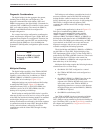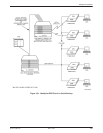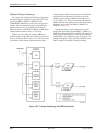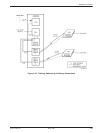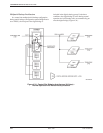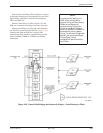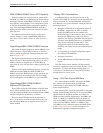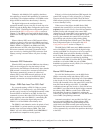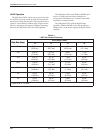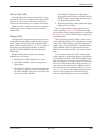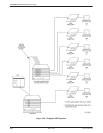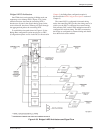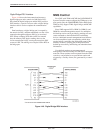
Principles of Operation
4-453610-A2-GB41-60 March 1999
Figure 4-37. Central-Site Bridging Architecture (56 kbps) – Active Digital Bridge
Central-Site DBM-Vs/DBM-Ss/DBM-Ds
At the central site, a DBM is required for each drop to
be backed up. A DBM-V may be used for V.32 backup.
For switched 56 kbps backup, a DBM-S is used for 4-wire
access and a DBM-D is used for 2-wire access to the
switched 56 kbps digital service. These DBMs require one
slot in the COMSPHERE 3000 Series Carrier. As an
alternative to using a DBM-V, DBM-S, or DBM-D, a
DSU-DBM with its Primary Core configuration option
enabled can be used for backup.
The carrier is controlled by the same network
management systems that control the Model 3611 DSU.
DBMs have the same diagnostic capabilities and Call
Setup security procedures as DBMs at the tributary
location.
The DBM-V, DBM-S, or DBM-S is addressed just as a
DBM is addressed via an NMS or the SDCP. Likewise,
configuration options are set just as they are set for a
DBM. (Refer to Chapter 5 of the COMSPHERE 3600
Series Data Service Units, Models 3610 and 3611, Dial
Backup Module and SNA Diagnostic Interface Options,
Applications Guide for in-depth instructions on how to set
DBM configuration options and issue dial backup
commands from the SDCP.)
Use DBM configuration option Single Rate set to Yes
to configure the DBM-Vs so the call is not set at a lesser
speed if line impairments are encountered. Each DBM
pair cannot be independent. If one dial-back line is set up
at a lower speed, its speed will not be the same as the
other ports on the digital bridge, and it can no longer
communicate. If the DBMs encounter line impairments,
the DBMs drop the present call and attempt to place a new
one.




